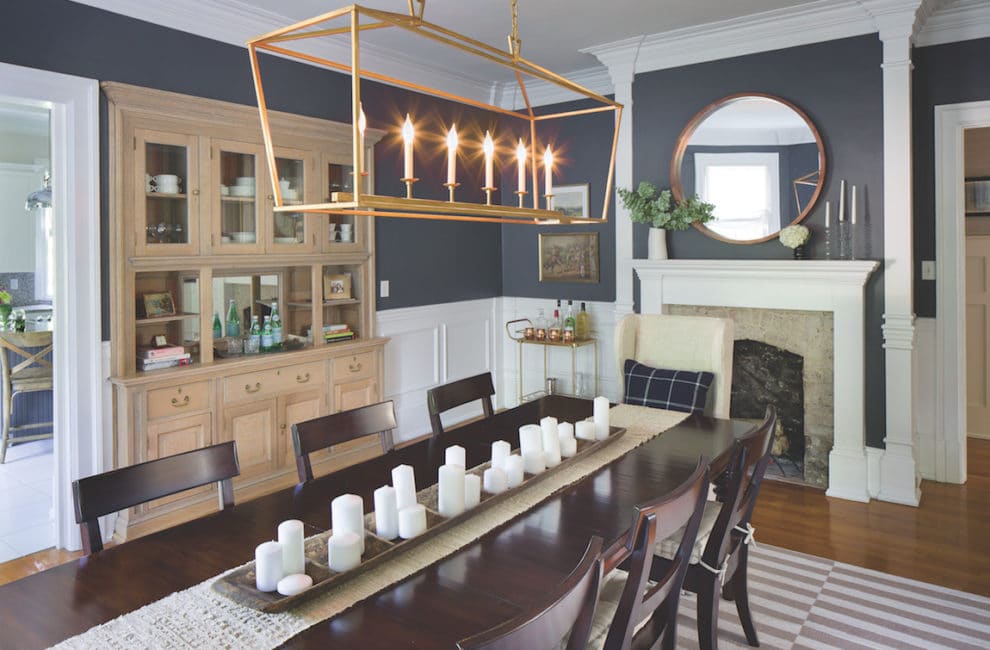
Home Of The Month: Fort Benjamin Harrison
Faux ivy is a faux pas for interior designer Ali Marten (and everyone, really). But when she and her husband, Tom, purchased their Fort Benjamin Harrison home in December 2011, the third-floor hallway was a thicket of hand-painted vines and glued-on ivy.
Another hall boasted imitation Venetian plaster. A fireplace was adorned with decoupaged paper soldiers. The back stairwell was painted to resemble a medieval castle. “It was very 1990s,” Ali laughs, “and kind of jarring.”
On top of that, the 8,100-square-foot home had been vacant for at least 15 years. What had once been the commanding officer’s residence was now a building punctuated by water damage and walled-over fireplaces. But beneath the deterioriation and layers of outdated trends, the Martens saw potential in the 10-foot-tall ceilings and original 1908 elements (hello, pocket doors) throughout the house. This is a piece of history, they thought. This needs to be saved.
Lawrence Township was still a rural place when Congress established Fort Benjamin Harrison in 1903 and the U.S. Army began acquiring land. Construction on the fort’s housing, barracks, barns, and service buildings began in 1906 and adhered to a site plan developed by the quartermaster general’s office. To create a cohesive, aesthetically pleasing community, all buildings used similar materials, such as brick, limestone, and slate. And since everything followed the Colonial Revival style, all of the fort buildings—including the Martens’ home—were defined by symmetry, accented doorways, and columned porches. But to distinguish the officers’ houses architecturally, ornamentation on the rooflines and windows of the houses helped define the function and rank of the person who lived there. For instance, the Marten residence has flat brick arches and limestone keystones above the windows.
“When you pull in, you feel like you’re going back in time,” Ali says. “A lot of people in Indy aren’t aware the fort is here, so it’s kind of a hidden gem.”
After the fort was decommissioned in the 1990s, it was nominated for the National Register of Historic Places. The nomination form notes that the Marten home had been divided into three apartments for officers and their families. And though the form describes the exterior as “unmodified,” it also says interior renovations had dramatically altered what was “the most ornate residence within the Fort complex.” Rumor has it, from a neighbor, that JFK once had dinner there when he was a senator.
It wasn’t until 1998, during the St. Margaret’s Hospital Guild Decorators’ Show House, that the home was restored to its original floor plan (except for the kitchen, where square footage quintupled). But with the showcase came the faux finishes, ivy and all. “That’s the tragedy with the renovations,” Ali says. “So much of the original features were torn out or painted over.”
Over the last several years, though, Ali and Tom—who owns a construction-management company—have been restoring the home. They scoured salvage shops to find matching knobs for the front doors. They also skimmed most of their ceilings, smoothing over decades of wear and tear. The front staircase took three weeks to strip, even with professional help. Unfortunately, Tom wasn’t as lucky with the hutch in the dining room. The layers of paint were as thick as a ream of paper, and after 200 hours of stripping, he stopped counting.
But in this six-bedroom, three-and-a-half-bathroom, six-working-fireplace home, the biggest challenges were hidden. Take the electrical system, for instance. Before Ali and Tom moved in, they had to replace the knob-and-tube wiring, which had been removed. Then there was the plumbing. And three HVAC units. And the fact that someone had removed a load-bearing wall from the back of the house. To fix it, Tom and his brother removed the ceiling, moved it up three inches, and reinforced it with a steel beam. “That was probably the biggest, most critical thing we did,” Ali says. “There’s a significant investment in things people don’t see. Sometimes you have to ask yourself, Is it worth the effort?”
That was a question she and Tom posed when deciding whether or not to re-expose the fireplace in the dining room, which had been dry-walled over.
“With this much square footage, you can easily over-invest,” Ali says. “We believe in quality and in not taking shortcuts, but it’s important to know when to stop, too.”
Ali and Tom have a running list of everything they’d still like to do—like addressing the hand-painted, rosy-cheeked cherubs in the back stairwell, updating the kitchen, and continuing to transform the third floor into a space for their two children, who already have a climbing wall that Tom built in two days.
While the Martens look forward to spending less time working on their home and more time enjoying it, they are excited to raise their children in a neighborhood that celebrates its history. Ali gestures toward the front windows—to the barracks, the sweeping parade grounds. “Where else do you grow up and have that kind of stuff in your front yard?” she says.







